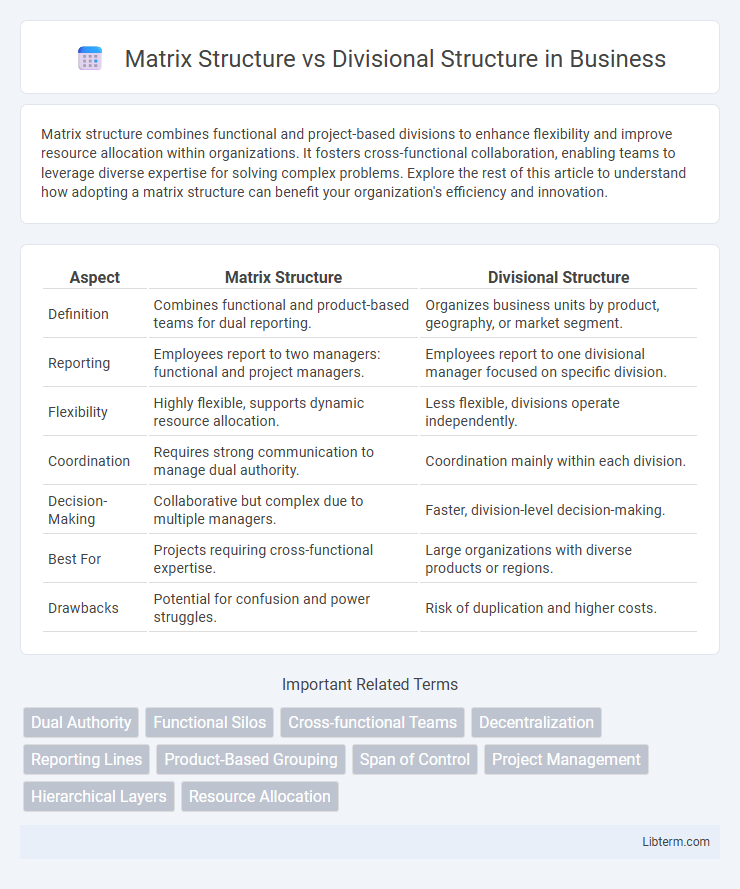Matrix structure combines functional and project-based divisions to enhance flexibility and improve resource allocation within organizations. It fosters cross-functional collaboration, enabling teams to leverage diverse expertise for solving complex problems. Explore the rest of this article to understand how adopting a matrix structure can benefit your organization's efficiency and innovation.
Table of Comparison
| Aspect | Matrix Structure | Divisional Structure |
|---|---|---|
| Definition | Combines functional and product-based teams for dual reporting. | Organizes business units by product, geography, or market segment. |
| Reporting | Employees report to two managers: functional and project managers. | Employees report to one divisional manager focused on specific division. |
| Flexibility | Highly flexible, supports dynamic resource allocation. | Less flexible, divisions operate independently. |
| Coordination | Requires strong communication to manage dual authority. | Coordination mainly within each division. |
| Decision-Making | Collaborative but complex due to multiple managers. | Faster, division-level decision-making. |
| Best For | Projects requiring cross-functional expertise. | Large organizations with diverse products or regions. |
| Drawbacks | Potential for confusion and power struggles. | Risk of duplication and higher costs. |
Introduction to Organizational Structures
Matrix structure integrates functional and project-based teams, enabling resource sharing and enhancing flexibility within organizations. Divisional structure organizes departments based on product lines, markets, or geographic regions, promoting focused expertise and accountability. Both structures address complex organizational needs but differ in hierarchy, decision-making processes, and communication flows.
Overview of Matrix Structure
Matrix structure combines functional and project-based divisions to enhance flexibility and collaboration by assigning employees to both functional managers and project leaders. This dual reporting system improves resource sharing and communication across departments, promoting innovation and adaptability in complex environments. Organizations using matrix structures often experience increased efficiency in handling diverse projects but may face challenges in balancing authority and resolving conflicts.
Overview of Divisional Structure
Divisional structure organizes a company into semi-autonomous units based on products, markets, or geographic regions, enabling focused management and responsiveness to specific customer needs. Each division operates with its own resources, including marketing, sales, and production teams, allowing accountability and clearer performance measurement. This structure enhances strategic flexibility but may lead to duplicated efforts and higher operational costs compared to more centralized designs.
Key Differences Between Matrix and Divisional Structures
Matrix structure combines functional and project-based teams, allowing employees to report to multiple managers, which enhances flexibility and collaboration across departments. Divisional structure organizes teams based on products, markets, or geographic regions, granting each division autonomy and focused accountability. Key differences include the matrix's dual-reporting system versus the divisional's single chain of command, and matrix's emphasis on resource sharing compared to divisional's independent operational control.
Pros and Cons of Matrix Structure
Matrix structures enhance flexibility by enabling employees to report to multiple managers, fostering better communication across departments and efficient resource utilization. However, this complexity can lead to confusion, conflicting priorities, and power struggles, potentially affecting decision-making speed and employee morale. Organizations with dynamic environments benefit from matrix structures, but clear role definitions and strong conflict resolution mechanisms are essential to mitigate its inherent challenges.
Pros and Cons of Divisional Structure
Divisional structure offers clear accountability and focus by grouping teams around products, markets, or regions, enhancing responsiveness and specialization. It allows for efficient handling of diverse product lines and customer segments but may lead to resource duplication and higher operational costs. Communication and coordination between divisions can become challenging, potentially causing conflicts or inconsistencies across the organization.
Decision-Making Processes in Both Structures
Matrix structure features dual reporting lines, enabling decentralized decision-making with greater collaboration across functions and projects, which can lead to faster adaptation but potential conflicts in authority. Divisional structure groups decision-making within autonomous units focused on specific markets or products, enhancing accountability and focused strategies but possibly causing duplication of efforts and slower cross-divisional coordination. The choice between matrix and divisional structures impacts the balance between flexibility, control, and speed in organizational decision-making processes.
Impact on Communication and Collaboration
Matrix structure fosters enhanced communication and collaboration by enabling employees to report to multiple managers across functional and project lines, promoting cross-departmental information flow. Divisional structure often results in siloed communication within each division, potentially limiting collaboration and creating challenges in sharing knowledge across product lines or geographic areas. Effective coordination in a matrix structure can lead to more agile decision-making and innovative problem-solving compared to the more rigid, division-focused communication patterns.
Suitability by Industry and Business Size
Matrix structure suits industries requiring high flexibility and collaboration across multiple functions such as technology, engineering, and consulting firms, often thriving in medium to large-sized businesses navigating complex projects. Divisional structure fits well in large, diversified corporations like automotive, consumer goods, and finance sectors where distinct product lines or geographic markets demand focused management and accountability. Small businesses typically favor simpler structures, but divisional setups can scale effectively for large enterprises needing clear divisions by product or region.
Choosing the Right Structure for Your Organization
Selecting the appropriate organizational structure hinges on company size, complexity, and strategic goals. Matrix structure suits organizations requiring flexibility and efficient resource sharing across projects, enhancing collaboration but demanding robust communication channels. Divisional structure benefits large, diverse companies with distinct product lines or markets, promoting focused management and accountability within semi-autonomous units.
Matrix Structure Infographic

 libterm.com
libterm.com